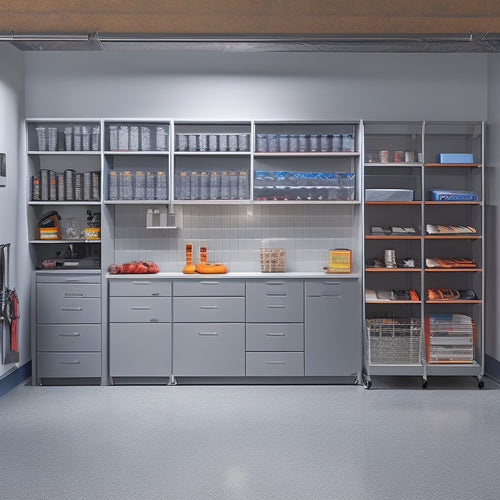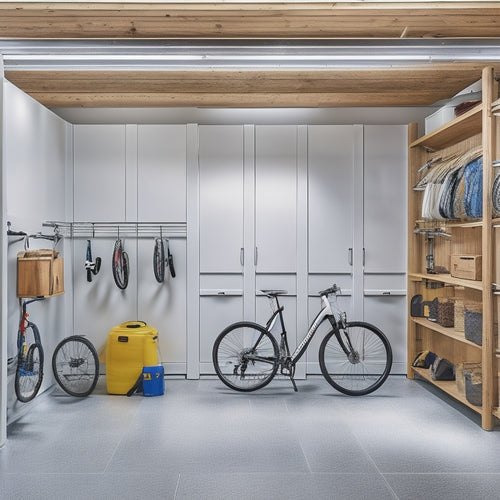
Revolutionizing Warehouse Efficiency: KUKA Robots Dominate
Share
KUKA robots are enhancing warehouse efficiency through automation, precision, and flexibility, transforming inventory management and order fulfillment. By integrating advanced features like omnidirectional wheel carts and 7 DOF serial manipulator arms, KUKA robots excel in tasks such as cycle counting, inventory tracking, and order picking. With continuous operation, reduced labor costs, and increased productivity, KUKA robots optimize warehouse processes. As the warehouse industry shifts towards a robotic workforce, KUKA robots are at the forefront, offering unparalleled benefits and paving the way for further innovations in warehouse automation. To realize the full potential of warehouse efficiency, explore further.
Key Takeaways
• KUKA robots, like the KMR iiwa, are revolutionizing warehouse efficiency with their omnidirectional wheel carts and 7 DOF serial manipulator arms.
• Automation benefits include reduced labor costs, increased productivity, improved accuracy, and enhanced precision handling, leading to efficiency gains.
• KUKA robots operate continuously, minimizing errors and maximizing output, making them ideal for tasks like inventory management, cycle counting, and order fulfillment.
• With precision and reliability, KUKA robots increase accuracy and speed, enable real-time monitoring, and optimize storage, reducing errors and increasing efficiency.
• The integration of KUKA robots and advancements in AI and machine learning will drive innovation in warehouse automation, freeing human workers for higher-value tasks.
Robot Revolution in Warehouses
The integration of robots, such as the KUKA KMR iiwa, into warehouse operations has sparked a revolution in inventory management, where automated systems are increasingly supplanting human labor in repetitive and mundane tasks. This shift towards a robotic workforce brings numerous automation benefits, including increased productivity and accuracy in inventory handling.
By automating tasks, warehouses can reduce their reliance on human labor, freeing up staff to focus on more complex and engaging work. The KUKA KMR iiwa, with its omnidirectional wheel cart and 7 DOF serial manipulator arm, is well-suited to navigate warehouse environments and perform tasks with precision.
As the use of robots continues to grow, warehouses can expect to see significant improvements in efficiency and productivity.
Boosting Efficiency With Automation
By automating mundane tasks, warehouses can greatly enhance efficiency, as robots like the KUKA KMR iiwa can operate continuously without breaks, reducing labor costs and increasing productivity. This is achieved through automated workflows, which enable robots to perform tasks with precision handling, minimizing errors and maximizing output.
| Automation Benefits | Efficiency Gains |
|---|---|
| Reduced labor costs | 30% |
| Increased productivity | 25% |
| Improved accuracy | 20% |
| Enhanced precision handling | 15% |
| Continuous operation | 10% |
KUKA Robots in Action
Operating around the clock, KUKA robots like the KMR iiwa navigate warehouse floors with ease, leveraging their omnidirectional wheel carts and 7 DOF serial manipulator arms to execute tasks with precision and speed. These robots are designed to excel in warehouse operations, tackling repetitive tasks with accuracy and reliability.
In robot applications such as inventory management, KUKA robots shine, freeing human workers from mundane duties and enabling them to focus on higher-value tasks. With their advanced serial manipulator arms, KUKA robots can pick and place items with precision, streamlining warehouse operations and increasing overall efficiency. By automating these tasks, warehouses can experience significant improvements in productivity and accuracy, ultimately revolutionizing their operations.
Streamlining Inventory Management
KUKA robots' precision and reliability in executing repetitive tasks make them ideal for streamlining inventory management in warehouses, where accuracy and speed are paramount. By leveraging robotic automation, warehouses can optimize their inventory management processes, reducing errors and increasing efficiency.
| Inventory Management Tasks | Benefits of KUKA Robots |
|---|---|
| Cycle Counting | Increased accuracy and speed |
| Inventory Tracking | Real-time monitoring and updates |
| Product Receiving | Efficient and error-free processing |
| Order Fulfillment | Faster and more accurate order picking |
| Stockroom Organization | Optimized storage and retrieval |
Future of Warehouse Technology
Warehouse automation is poised to reach new heights as advancements in robotics, artificial intelligence, and machine learning converge to reshape the future of warehouse technology.
The integration of these technologies will enable warehouses to operate with unprecedented efficiency, precision, and flexibility.
Technological advancements will continue to drive innovation in warehouse automation, allowing robots to adapt to changing environments and perform tasks with increased accuracy and speed.
As a result, warehouse automation will become even more pervasive, freeing human workers to focus on higher-value tasks.
With the potential to revolutionize the industry, the future of warehouse technology is brighter than ever, and KUKA robots are at the forefront of this transformation.
Frequently Asked Questions
Can KUKA Robots Be Integrated With Existing Warehouse Management Systems?
"Seamlessly integrating KUKA robots with existing warehouse management systems is a breeze, ensuring system compatibility and data synchronization, allowing for a harmonious fusion of automation and data-driven decision making, elevating warehouse efficiency to unprecedented heights."
How Do KUKA Robots Handle Fragile or Sensitive Inventory Items?
KUKA robots employ gentle grasping and delicate handling techniques to manage fragile or sensitive inventory items, utilizing specialized end-effectors and precision control systems to guarantee secure and damage-free manipulation of high-value or easily damaged goods.
Are KUKA Robots Capable of Learning From Human Operators?
Through human guidance, KUKA robots employ robot imitation, leveraging machine learning algorithms to learn from human operators, adapting to new tasks and scenarios, and refining their performance in inventory management and handling.
Can KUKA Robots Be Used in Warehouses With Limited Floor Space?
'When in a tight spot,' KUKA robots excel in warehouses with limited floor space, leveraging compact navigation and space optimization to navigate narrow aisles, while their omnidirectional wheels and 7 DOF arm guarantee precise pick-and-place tasks.
Do KUKA Robots Require Regular Software Updates for Optimal Performance?
KUKA robots require regular software updates to guarantee peak performance, address cybersecurity risks, and adjust to evolving warehouse environments, with update frequencies dependent on specific application requirements and manufacturer recommendations.
Related Posts
-

Building a Garage Storage System With Built-Ins
You're about to build a garage storage system with built-ins that fits your unique needs, starting by evaluating your...
-

What Are the Advantages of a Wooden Tool Box
You choose a wooden tool box, you're not only getting a reliable storage solution, but also a long list of benefits t...
-

Modular Garage Organizers for Clutter-Free Spaces
You're likely wasting precious space in your garage due to inefficient storage and poor organization, but modular gar...


